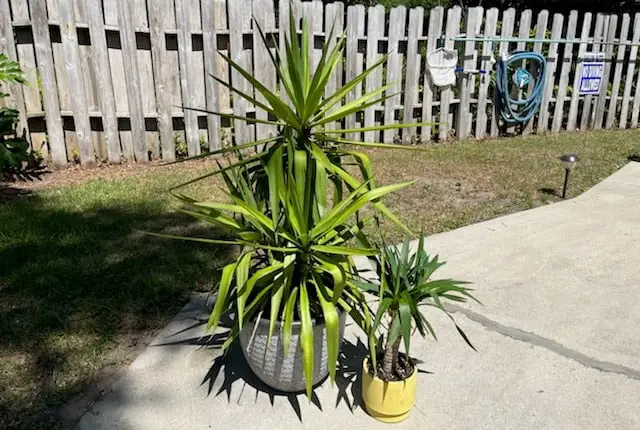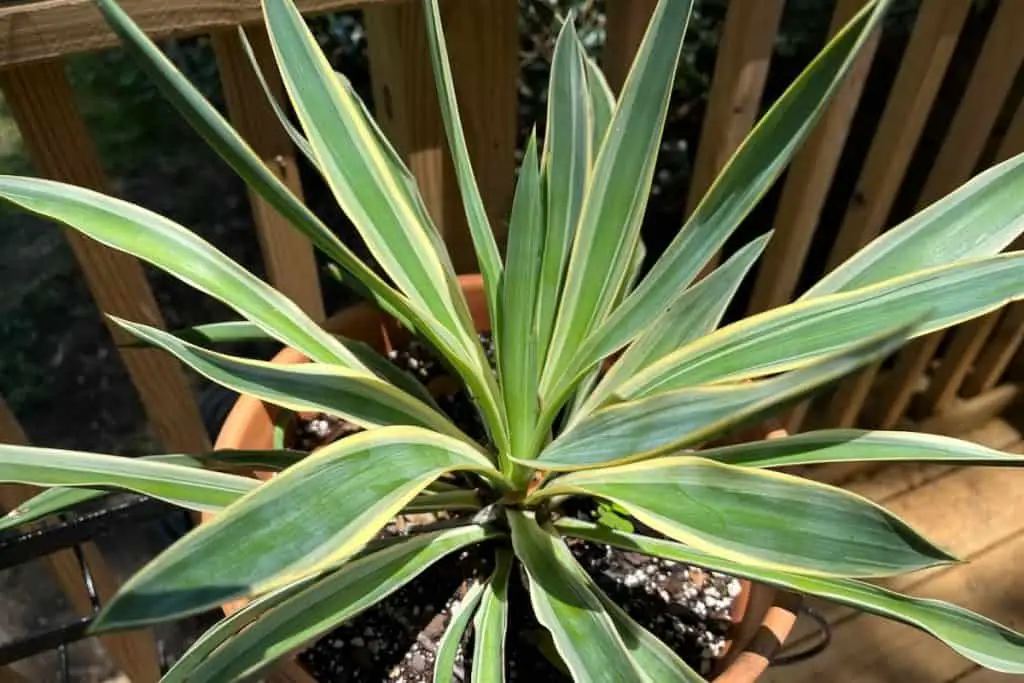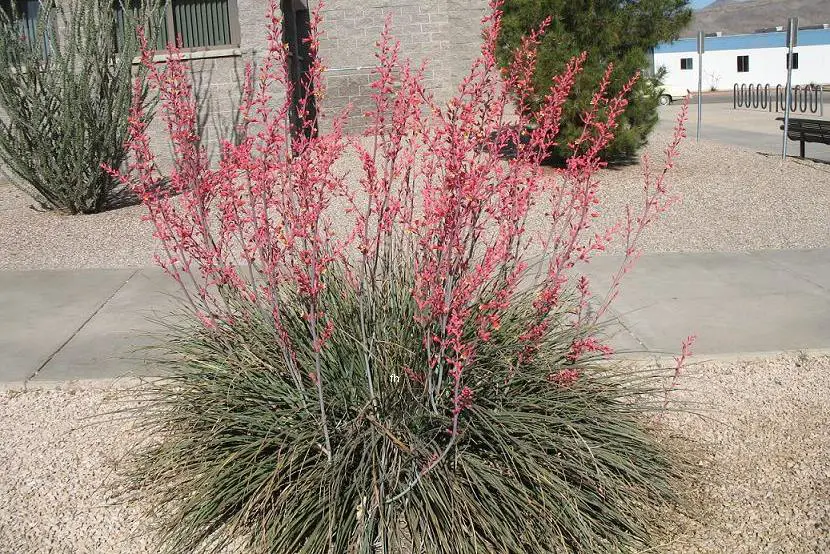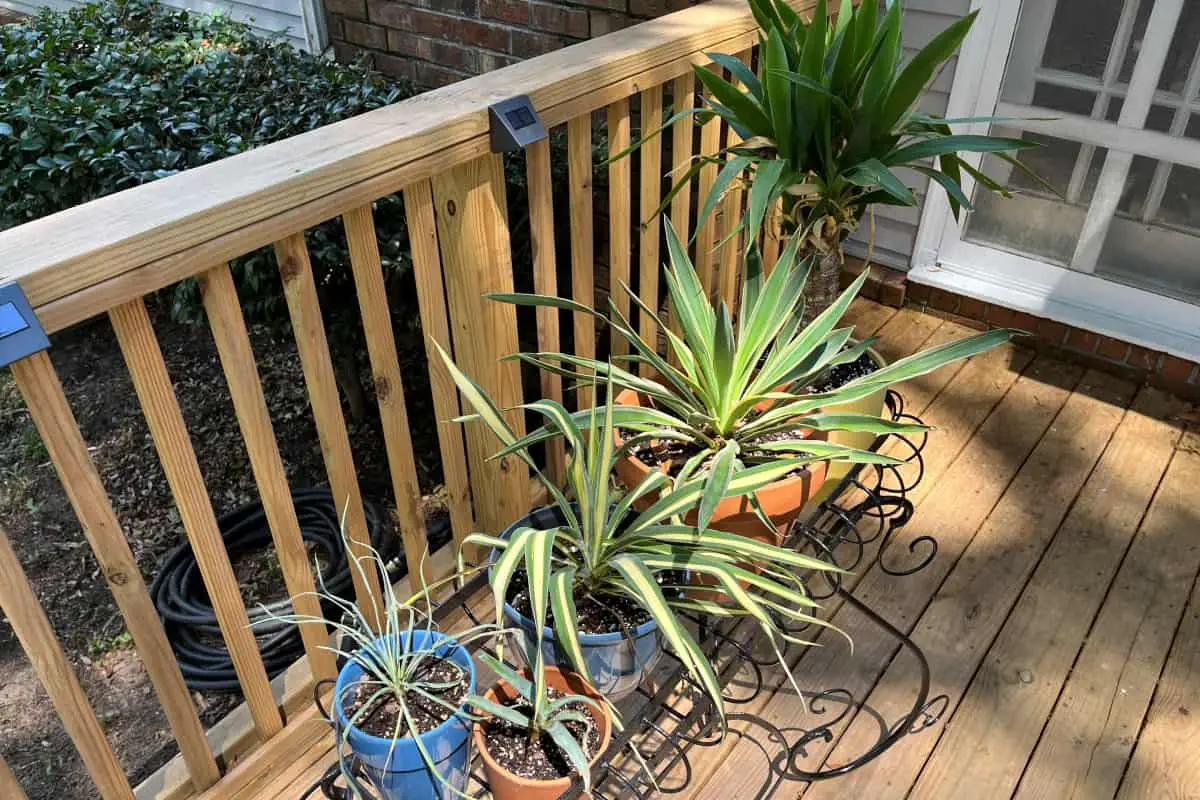These most popular yucca plants will give you a place to start researching yucca varieties. When choosing a type of yucca, it can be easier to find ones that are popular and in demand.
Are you wondering what the most popular yuccas are? If you are trying to find yucca plants to grow, it can be easier to find popular ones, since suppliers will be easier to locate. This article will focus on the nine most popular yucca while giving a concise overview of each one.

Yucca Elephantipes (Spineless Yucca, Cane Yucca)
The Spineless yucca is a very popular choice for those growing yucca plants. This is because these yucca leaves are not as rigid and do not have a sharp needle-like point at the end like most other yucca varieties. This makes them easier and safer to handle.
Spineless yucca is also known as Yucca elephantipes. It is a common house plant yucca, but also grows well outdoors in:
- Florida
- Texas
- Arizona
- California
- Southern Oregon
It is native to Mexico and Central America.
This variety of yucca can grow to 30 feet in height with a fifteen-foot spread, making it an ideal landscape plant in warmer, coastal areas. It does will under humid conditions.
As a houseplant, the Spineless yucca can reach ten feet. Whether growing indoors or outdoors, you can expect it to grow evergreen foliage that spirals up from the plant’s trunk. When in the ground it’s capable of growing large, showy flowers that can range in color from cream to gray.
The Spineless yucca is often propagated through cuttings and can produce branching. These plants thrive in well-drained soil with plenty of sunlight. They are strongly drought tolerant but do well in tropical climates such as Hawaii. Spineless yucca makes an excellent coastal plant and are moderately salt aerosol tolerant. These yucca do well potted and look great around a pool.
Hey, you’ll like this one too: Spineless Yucca Explained

Filamentosa (Color Guard)
Filamentosa is also known as the Adam’s Needle or Color Guard yucca. It is a showy yucca and is a popular ornamental yucca with stiff, variegated leaves that range in color from green to creamy yellow. They can grow to six feet in height with the flower stalk.
Filamentosa is known by a variety of names. These include
- Carolina Silk Grass
- Spoonleaf Yucca Color Guard
- Spanish Bayonet Color Guard
- Our Lord’s Candle Color Guard
- And more.
This yucca does not get as tall as some of the other varieties. It will grow to be around three feet in height and spread around two to three feet in width. The tips of the Filamentosa are needle sharp, and have been used throughout time as a needle and thread for sewing.
Yucca Filamentosa is beautiful and showy all year long. This yucca will grow for about three years. When the blooms and the plant wilt, it is important to cut the plant down close to the ground to allow the new yucca plants to grow.
This type of yucca will spread through the garden via its deep roots, which can be pretty difficult to dig up. So, this should be considered before planting in a garden. Also, care should be taken when planting where pets and children will be, due to the sharp-pointed leaves and toxicity to pets that might chew on the leaves.
Hey, you’ll like this one too: Are Adam’s Needle and Color Guard the Same Thing

Yucca Gloriosa
The Yucca Gloriosa is commonly known as the Spanish Dagger. It is native to North Carolina and Florida, where it is usually found growing on the coast. The Spanish Dagger can be grown as a shrub or tree with a maximum height of sixteen feet. They are slow growers.
Yucca Gloriosa is a hardy type of yucca that enjoys sandy well-drained soil. It is tolerant to salt spray and even the occasional snow. Because the Spanish Dagger is so versatile, it can be grown in places with high humidity or drought areas. It also does well as a house plant.
The Yucca Gloriosa blooms in the late spring and into midsummer and has a pinnacle with large bell-shaped white flowers. As this yucca grows in height and the lower leaves fall from the plant, the stalk will become more bark-like, resembling the trunk of a tree. Variegated varieties can also be found.
Hey, you’ll like this one too: All About Yucca Goriosa or Spanish Dagger

Desmetiana (Blue boy)
The yucca Desmetiana or Blue Boy is a unique plant in the yucca family. It has blue-gray leaves that become more purple as they age. It will grow to be around six feet tall and five feet across. The leaves are soft and rubbery.
The exact origins of the Blue Boy yucca are unknown, as none have been found growing in the wild. However, the color variations of the leaves and how they arch gracefully bring attention to this beautiful plant, making it desirable for yucca gardeners.
Desmetiana can be grown as a houseplant or in a garden. They enjoy well-drained soil and can be grown in hot, dry climates and humid moist climates. Though rarely seen, it can produce blooms July through August with translucent white drooping flowers.

Rostrata
The showy Rostrata, also known as Blue Beaked yucca, is tree-like and can reach fifteen feet, with a total span of ten feet in width. The blue-green leaves form a perfect pom-pom rosette on top of a tree trunk lime stalk. Rostrata is native to the Southwestern states.
Blue Beaked yucca are a beautiful addition to the garden. They are drought and cold resistant, meaning they can be planted in dry landscapes and can reach winter temperatures of -10 degrees Fahrenheit.
Blue Beaked Rostrata will form hundreds of two-foot leaves. These leaves are a beautiful blue-green with a sharp point at the end. However, they do not have a rigid leaf, making them safer for people and animals.
It likes full sun with well-drained alkaline soil. In the spring, a tall orangish flower stalk will erupt from the top of the yucca and produce white blooms. Blue Beak can be grown from seed or a cutting. It is important to note that it is toxic to animals, and should be planted in areas where pets and horses do not frequent.

Yucca Aloifolia (Spanish bayonet, aloe yucca)
Yucca Aloifolia is well known by a few names. These include:
- Spanish Bayonet
- Aloe Yucca
- Dagger Plant
- Spanish Dagger
The Atlantic and Gulf coasts are their native habitat. It grows ten to fifteen feet tall with a width of three to five feet. It produces clusters of large white flowers in spring and summer.
The Yucca Aloifolia has sharp and rigid dark green foliage. It stops growing after it has flowered. It then produces offshoots that can become dense, making this an excellent security plant, as no one will attempt to walk through it.
Yucca Aloifolia flowers are fragrant. Both the flowers and fruit are edible. The sharp leaves should be handled with care. Be sure to protect your eyes and skin when interacting with this yucca. Watch your pets, and do not let them chew or eat the foliage, as it is toxic to them.

Hesperaloe Parviflora (Red Yucca)
Red Yucca is one of the most popular and readily available plants. It is known by a variety of names including:
- Coral Yucca
- Hummingbird Yucca
- False Yucca
- Samandoque
Though it resembles a yucca, it is not a yucca at all. It is a century plant.
Red yucca is easy to grow. It is a drought tolerant plant native to the Southwestern deserts. This plant does very well in extreme heat conditions; it can tolerate cold temps to ten degrees. It requires full sun and well-drained soil.
The blue-green foliage stays close to the ground with semi-rigid leaves. In the winter, Red yucca leaves will turn a reddish purple color. It will produce a thin, five-foot-tall flower stalk with coral colored blooms in the spring. However, the flowers can also be yellow.
Hey, you’ll like this one too: What is a Red Yucca

Dwarf Yucca (Harrimaniae, Nana)
The Dwarf Yucca is a miniature variety of yucca that is native to Utah, Colorado and Southwest high deserts. It will grow to a height of one foot and a width of one foot. When it flowers, it will be three to five feet tall. It makes the same beautiful flowers as a standard size yucca.
Dwarf Yucca is also known as:
- Harrimaniae yucca
- Nana yucca
- Narrow Leaf yucca
- New Mexico Spanish bayonet
- New Mexico Yucca
The flowers and fruit are edible, and the leaves can be used for weaving.
Dwarf yucca enjoys full sun and well-drained rocky soil. Over time it will produce a small colony of yucca around it. However, it is very slow growing, so this colony will not arrive immediately. The foliage is green with edges of brown. The Dwarf yucca blooms in the summer producing large white flowers.

Breviofolia (Joshua Tree)
Joshua Tree also known as Breviofolia can live to an estimated 150 years of age. They are native to the Mojave desert and grow as a branching succulent tree. It produces greenish white flowers from the foliage topped branches in the spring.
The Joshua Tree is a protected species and requires a permit to relocate from the wild. They need plenty of space as they will grow twenty feet to seventy feet tall in the right conditions. This growth will be very slow at half to three inches per year.
These whimsical looking yucca trees are drought tolerant, easily living in summer temperatures of 120 degrees Fahrenheit. They can also withstand winter temperatures of twelve degrees. The joshua tree requires a hot season and a cold snap to survive.
The Most Popular Yucca
Yucca are becoming more popular as people learn how easy it is to grow and care for them. These large, flowering succulents bring a sense of awe to the landscape garden and become an excellent focal point as a houseplant. These popular yucca varieties can live and thrive in various planting zones.
If you’re looking for a houseplant, the most popular yucca is the spineless yucca. But don’t discount some of the other ones. Both the Gloriosa and Color Guard make stunning additions to a home.

